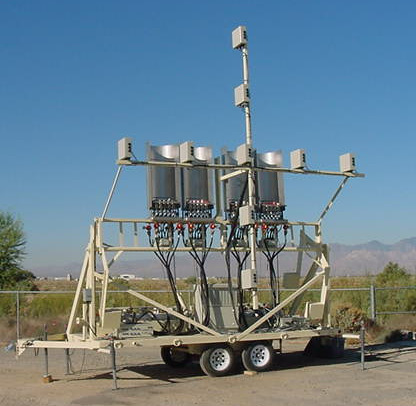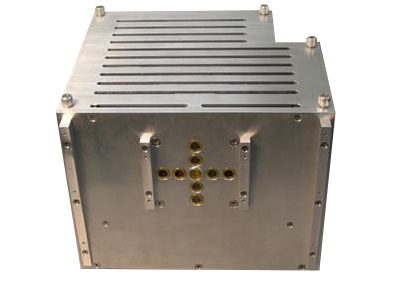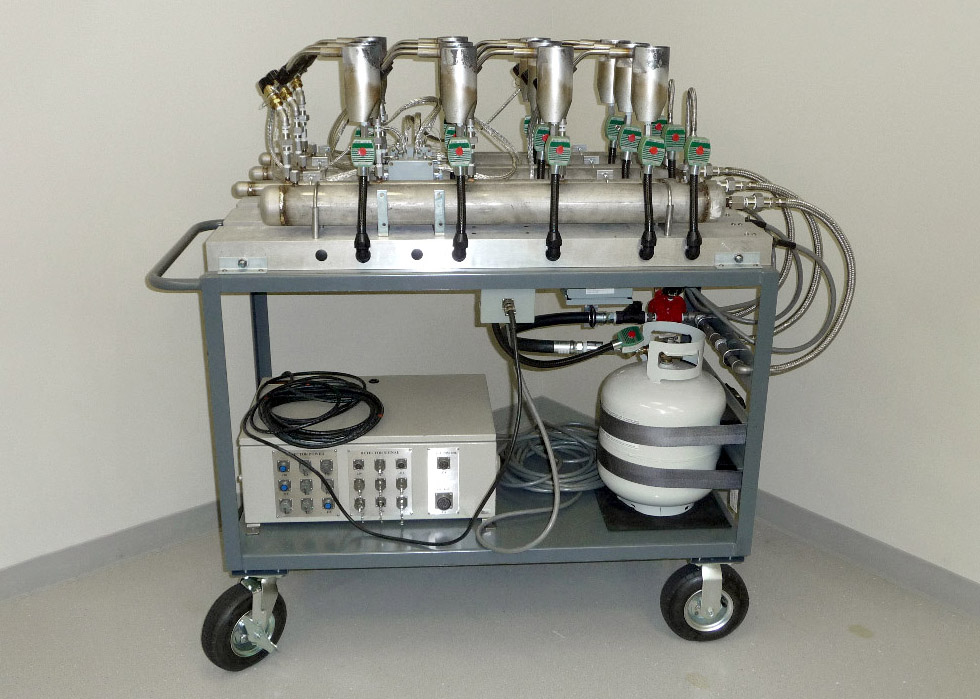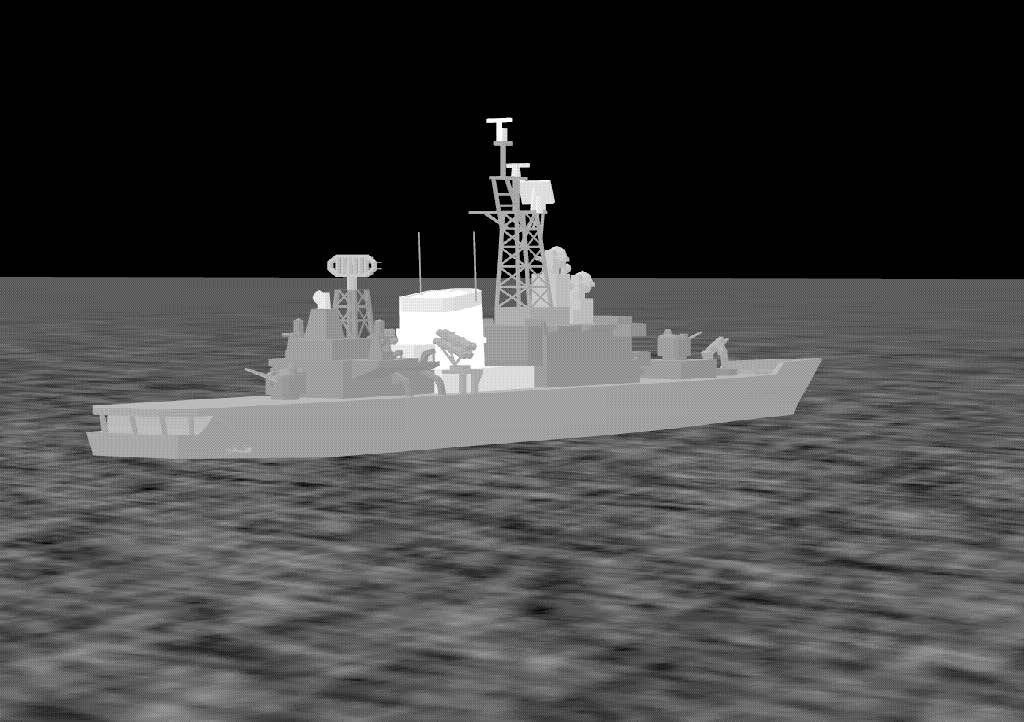
RealIR™ API for IR Sensor Simulation
Technology Service Corporation (TSC) developed the RealIR™ application programming interface (API) to provide a toolkit for real-time sensor simulation developers. The RealIR API implements physics-based models for thermal IR sensor simulation, compatible with standard scene database formats and real-time simulation engines. The API has been incorporated in simulations for both man-in-the-loop training systems and hardware-in-the-loop simulation systems.
PRODUCT DESCRIPTION
The RealIR API meets the needs of users who require a dynamic IR simulation that can be rapidly reconfigured during the simulation run. The API provides complete functionality for incorporating a physics-based IR model into a real-time simulation. Using the API, a simulation application can continuously update the simulated IR sensor imagery. The RealIR API functions include sensor specification, real-time modification of environment and atmosphere, physics-based computation of scene temperatures and radiances, atmospheric propagation using LOWTRAN or MODTRAN, and real-time visualization with 8, 12, or 16-bit image depths. The API also provides automatic conversion of terrain and target textures to physically correct IR textures. In addition to the IR physics library, the API contains functions for loading OpenFlight target and terrain models and performing real-time visualization using the OpenSceneGraph API. TSC recently (2013) added additional functions to provide an option for real-time conversion of visual terrain databases to IR intensities using GPU technology, eliminating the time and storage required for material mapping and off-line conversion.
WHY REAL-TIME IR SIMULATION?
Use of thermal IR imaging sensors is increasing in both military and commercial sectors for day/night surveillance, navigation, and fire control. IR simulation is essential for the development of these sensors, and for operator training. Thermal IR imagery is highly dependent on local conditions, and can change dramatically within a few hours. Only a physicsbased simulation system such as RealIR can provide realistic simulated IR imagery under all operating conditions.
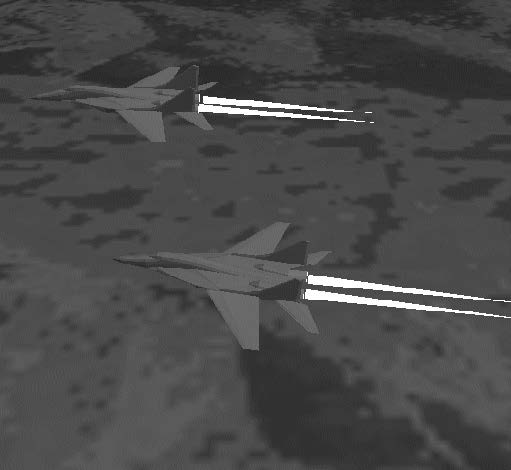
ABOUT TSC
TSC has extensive experience in IR and radar sensor simulation. The RealIR API is used by many companies and government agencies for training and simulation. Our numerous customer applications include UAV operator training, enhanced vision flight simulation, and hardware-in-the-loop seeker testing. We can provide support or deliver a turnkey simulation with RealIR to fit your specific needs and applications.
Infrared (IR) and Ultraviolet (UV) Radiometer System
Technology Service Corporation (TSC) has developed a modular infrared (IR) and ultraviolet (UV) radiometer system for radiometric measurement and monitoring of IR/UV sources and simulations. Radiometer signals are digitized in the radiometer heads allowing cable lengths of up to 200 feet to the Data Acquisition Unit (DAU). The system has the following features:
- Simultaneous data collection for up to five separate IR/UV radiometer heads
- 30 kHz data-sampling rate (10 kHz electronics bandwidth)
- Real-time data display, data averaging, and FFT processing
- Intuitive LabVIEW Operator Interface for radiometer configuration and control
- Outdoor operational capability for ambient temperatures up to 100 °F
- Low-Voltage Differential Signaling (LVDS) of radiometer digital data to DAU
- External DAU TTL start-trigger
- GPS/IRIG option for data time stampingThe radiometer system consists of a portable PC-based Data Acquisition Unit, a Power/Data Interface Unit, up to five radiometer heads, and related cabling.
The radiometer heads contain the detectors and digitizing electronics. The detectors are DC coupled (a chopper is not required) and have low 1/f noise, making them ideal for low- frequency signal monitoring, while the 30 kHz sampling rate and 10 kHz electronics bandwidth allow high- frequency signal components, e.g., spikes to be observed (> 1 msec time resolution). The DAU acquires, stores, and graphically displays the radiometer data; data averaging and FFT processing are readily performed.
Technology Service Corporation (TSC) has developed a modular infrared (IR) and ultraviolet (UV) radiometer system for radiometric measurement and monitoring of IR/UV sources and simulations. Radiometer signals are digitized in the radiometer heads allowing cable lengths of up to 200 feet to the Data Acquisition Unit (DAU). The system has the following features:
- Simultaneous data collection for up to five separate IR/UV radiometer heads
- 30 kHz data-sampling rate (10 kHz electronics bandwidth)
- Real-time data display, data averaging, and FFT processing
- Intuitive LabVIEW Operator Interface for radiometer configuration and control
- Outdoor operational capability for ambient temperatures up to 100 °F
- Low-Voltage Differential Signaling (LVDS) of radiometer digital data to DAU
- External DAU TTL start-trigger
- GPS/IRIG option for data time stampingThe radiometer system consists of a portable PC-based Data Acquisition Unit, a Power/Data Interface Unit, up to five radiometer heads, and related cabling.
The radiometer heads contain the detectors and digitizing electronics. The detectors are DC coupled (a chopper is not required) and have low 1/f noise, making them ideal for low- frequency signal monitoring, while the 30 kHz sampling rate and 10 kHz electronics bandwidth allow high- frequency signal components, e.g., spikes to be observed (> 1 msec time resolution). The DAU acquires, stores, and graphically displays the radiometer data; data averaging and FFT processing are readily performed.
| Radiometer | IR | UV |
|---|---|---|
| Detector | HgCdTe | Si photodiode |
| Wavelength Band | 1 – 5 μm* | 200 – 300 nm* |
| Sensitivity | 4 x 10-8 W/cm2 | 3 x 10-9 W/cm2 |
| Dynamic Range | > 30 dB | > 30 dB |
| Field of View (FOV) | 40 deg | 40 deg |
| Sampling Rate | 30 kHz | 30 kHz |
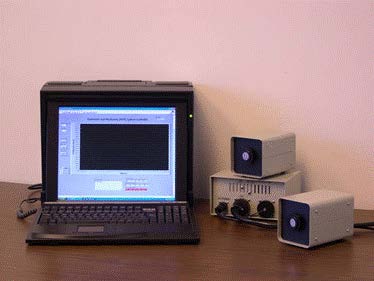
Infrared/Ultraviolet Simulators and Related Systems
United States and allied aircraft to protect against surface-to-air and air-to-air missile threats. Hostile fire indication (HFI) is being integrated into the missile warning requirement, and separate hostile fire detection systems are under development. Systematic test and evaluation (T&E) of these electronic warfare systems is required at all levels, including hardware-in-the-loop (HITL), installed system test facility (ISTF), and open-air range (OAR). High-fidelity simulations that reproduce the spectral, temporal, and spatial characteristics of threat signatures are critical to accomplishing the T&E requirement. Infrared monitoring systems for evaluating DIRCM are also required. Technology Service Corporation (TSC) has developed and demonstrated IR/UV missile signature simulators, DIRCM monitors, HFI threat simulators, and related components for HITL, ISTF, and OAR applications.
- TSC developed a Target Board Evaluator (TBE) system for the Air Combat Environment Test and Evaluation Facility (ACETEF), Naval Air Warfare Center, Patuxent River, to be used for T&E of DIRCM systems. A cruciform array of eight multi-channel lead-selenide detectors monitors DIRCM performance in mid-IR bands I, II, and IV. A quantum cascade laser (QCL) emits from the central position of the cruciform to simulate missile threat signatures to the DIRCM IR tracker.
- The IR/UV Source Stimulator (IRUSS) system developed for the Benefield Anechoic Facility (ISTF) at Edwards AFB consists of computer-controlled IR and UV point sources that simulate the spectral, temporal, and spatial characteristics of surface-to-air and air-to-air threat missiles. Spatial simulation is accomplished by coupling the output of an IR/UV source via fiber optic cable to a computer-controlled motion rail system.
- The IR Simulator and Target Array (ISTAR) system was developed for the Electronic Combat Range (OAR) at the Naval Air Warfare Center, China Lake. The IR Simulator consists of ten trailer-based liquid-propane flame sources that are configured to simulate surface-to-air missile signatures. Target or detector arrays perform declaration and monitoring of the DIRCM beam.
- TSC has developed a Hostile Fire Indicator Threat Simulator (HFITS) for simulating ground-fire muzzle flashes to HFI systems under test.
- TSC has developed a computer-controlled Multi-Color Filter System for the IR Simulation (HITL) at the Air Force Electronic Warfare Evaluation Simulator facility in Fort Worth, Texas. The system is used to dynamically shape the spectral output of xenon lamps used to simulate infrared.
